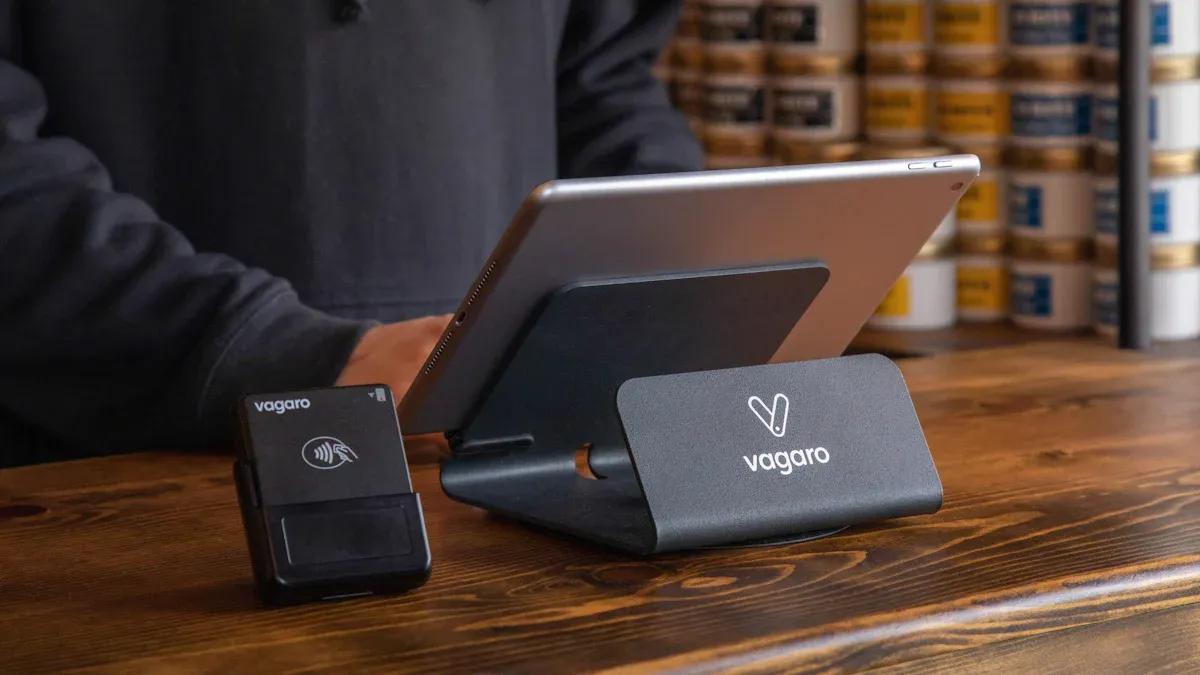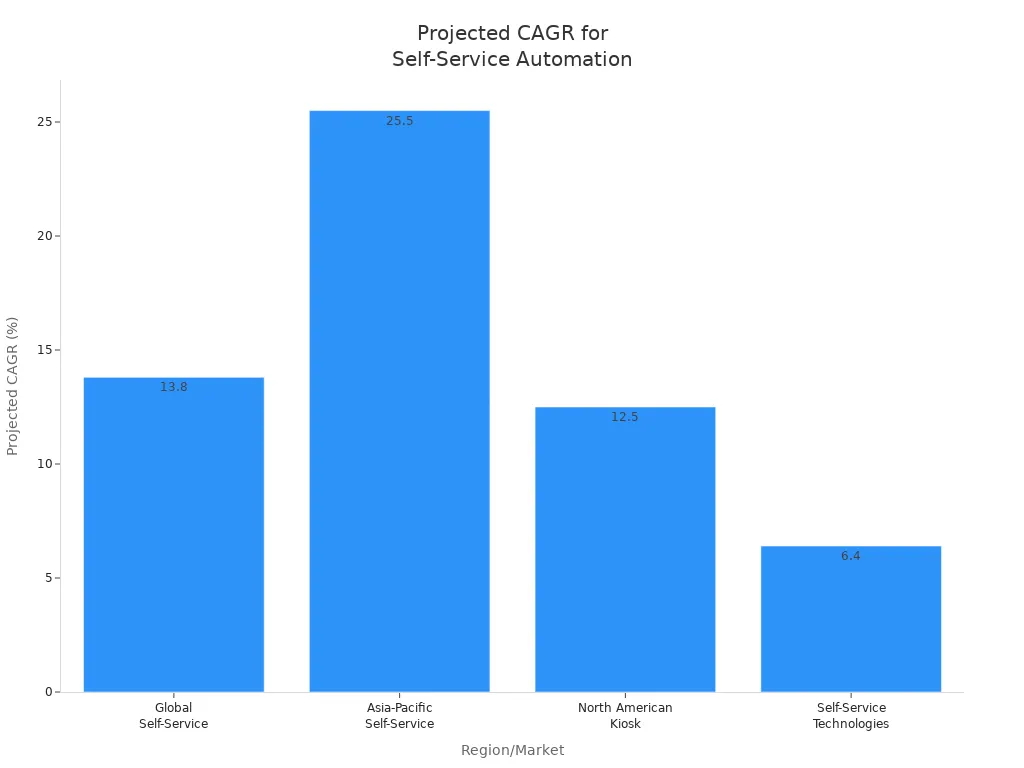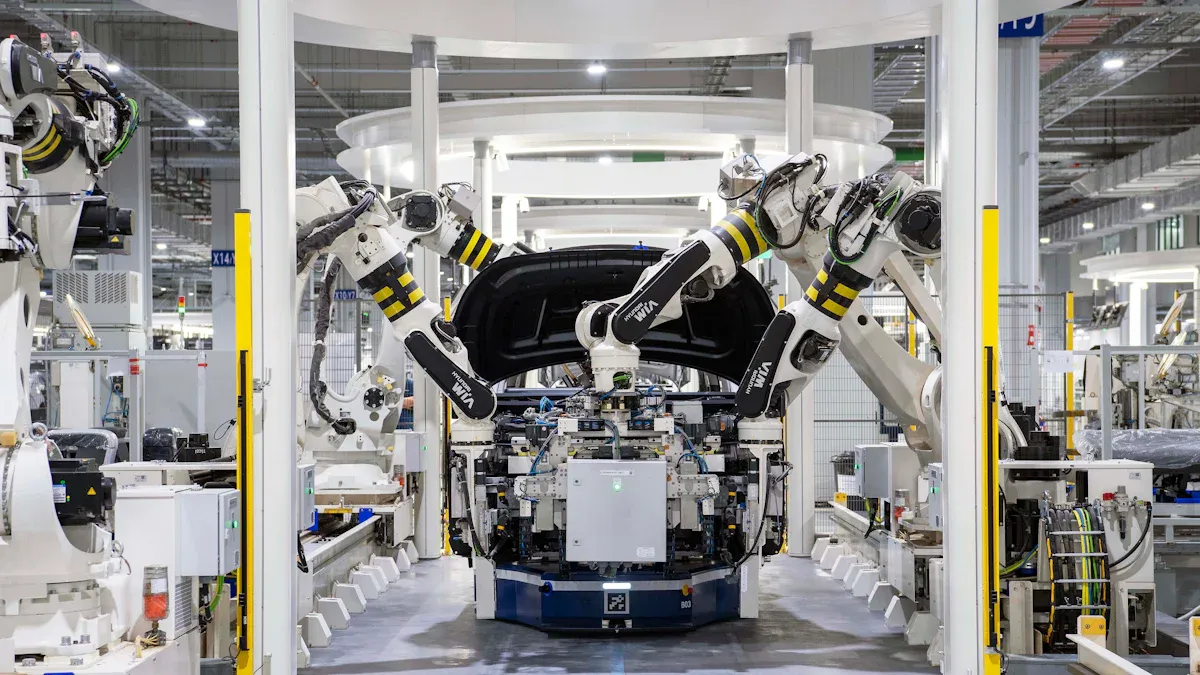Key trends shaping the self-service store automation market

Self-service store automation is growing fast in retail. The market was worth $43.14 billion in 2024. It is expected to reach $125.42 billion by 2033. The growth rate is 12.59% each year.
Year | Market Size (USD Billion) | CAGR (%) |
|---|---|---|
2024 | 43.14 | N/A |
2025 | 48.57 | N/A |
2033 | 125.42 | 12.59 |
These trends help retailers, technology providers, and investors in many ways:
Retailers use automation to work better and spend less on workers.
Technology providers make new tools using AI and robotics.
Investors see chances to invest in companies that create new ideas.
More self-service store automation helps businesses keep up with what customers want and work better.
Key Takeaways
Self-service store automation is growing fast. It may reach $125.42 billion by 2033. This helps stores save money and work better.
AI and robotics are changing how stores work. They make checkouts quicker and help manage stock smarter. This makes customers happier.
Contactless payment is now very important. About 41% of people like stores with this option. It makes buying things faster and safer.
Smart inventory systems help stores keep the right amount of stock. This cuts down on waste and keeps popular items in stock.
Automation makes shopping easier and more personal. It also makes it faster. This helps stores keep their customers coming back.
Self-service store automation: Market Growth

Market Size
Self-service store automation is growing in many countries. The market was $53.32 billion in 2025. Experts think it will reach $131.83 billion by 2034. It grows at a rate of 10.58% each year. This fast growth means stores and tech companies spend more on new ideas.
Self-service technology is also growing in different places and types of stores. The table below shows how much the market could grow:
Region/Market | Projected CAGR | Projected Value by 2030 |
|---|---|---|
Global Self-Service Technology | 13.8% | $92.24 billion |
Asia-Pacific Self-Service Market | 25.5% | $12,995.5 million |
North American Kiosk Market | 12.5% | $17.01 billion |
6.4% | $41.96 billion (2025) |

Growth Drivers
Many things help self-service store automation grow. Stores want shopping to be easier and faster for people. Shoppers like quick checkouts and short lines. Better technology lets stores use kiosks and self-checkout more.
Note: COVID-19 made contactless options more common. Stores added kiosks to help people avoid touching things.
Other reasons for growth are:
Fast internet and mobile phones help with mobile payments.
Not enough workers and higher pay make stores use more automation.
Governments support digital changes in stores.
Omnichannel retail connects online and in-store shopping.
New tech like AI and CRM systems help stores know customers better.
The table below explains how new technology helps self-service store automation:
Evidence Description | Impact on Self-Service Store Automation |
|---|---|
Voice-activated systems and mobile checkout using AI. | Makes shopping easier and more fun for customers. |
AI-powered self-checkout helps stores work better and know shoppers. | Stores run smoother and customers are happier. |
AI makes transactions faster and smarter. | People wait less at checkout. |
More mobile payments make shopping quicker. | People pay faster and enjoy shopping more. |
Better data analytics help manage inventory. | Stores keep track of products and have fewer mistakes. |
Unmanned store tech uses computer vision to find products. | No need for checkout lines, so shopping is faster. |
Adoption Rates
Many types of stores now use self-service store automation. Quick-service restaurants used 43% more kiosks worldwide in two years. By mid-2023, there were almost 350,000 kiosks in restaurants around the world.
Adoption rates are not the same everywhere. Big retail chains and supermarkets make up 61.4% of adoption. North America uses advanced tech and wants to work better. The United Kingdom grows because shoppers want new things and shop online more.
Region/Format | Adoption Rate Contribution | Key Drivers |
|---|---|---|
Organized Market | 61.4% | More big stores and supermarkets need the same processes everywhere |
North America | N/A | New technology and the need to work better |
United Kingdom | N/A | Shoppers want new things and more people shop online |
Stores keep using self-service store automation to help customers and work better. The market is growing fast and more stores are using these systems in many places.
Key Trends In Automation

AI Integration
Artificial intelligence is changing how stores work. The retail operations software market is getting bigger. It could be worth $1.39 billion by 2025. AI helps stores do things faster and smarter. AI-powered retail platforms make checkout easier and help with inventory. McDonald's uses AI in drive-throughs to get orders right and make lines shorter. Self-checkout systems with AI use computer vision to spot items. This makes paying quicker. These systems also watch what customers do. Stores can put products in better spots and make lines shorter.
AI-powered platforms make checkout and inventory better.
AI in drive-throughs helps get orders right.
Real-time analysis helps stores serve people better.
AI helps stores guess what people will buy. It looks at sales data to help stores not run out of things. It also stops stores from having too much stuff. AI-driven scheduling systems guess when stores will be busy. This helps stores have enough workers. Automated inventory systems keep shelves full. AI does simple jobs, so staff can help customers more.
Evidence Description | Impact on Operational Efficiency |
|---|---|
AI-driven scheduling systems use data to guess busy times and what customers want. | Stores can put workers where they are needed, saving money. |
Automated inventory systems with AI make restocking easier. | Shelves stay full, so customers are happy and stores sell more. |
AI does boring jobs, so staff can do more important things. | Stores save money and work better. |
Contactless Solutions
Contactless solutions are getting more common in stores. Shoppers want more control and faster checkouts. Touchless payments use RFID or near field identification. This lets people pay quickly and safely with cards or phones. AI-assisted checkouts make fewer mistakes and help stores sell more. Virtual reality tools help design better checkout spaces. Biometric authentication, like fingerprints or face scans, makes paying safer and easier.
Touchless payments use RFID and mobile wallets.
AI-assisted checkouts make fewer mistakes.
VR tools help design better checkouts.
Biometric authentication makes payments safer.
Stores are adding more self-checkout machines. By 2029, there could be 2 million of them. Many shoppers use self-service, and stores see bigger orders when people order themselves. Contactless payments make paying twice as fast as chip and PIN. Self-checkout lanes make paying quicker and give staff less work. Stores say customers come back more because shopping is easier.
Statistic | Insight |
|---|---|
41% of consumers | Will not shop where there are no contactless options. |
Statistic | Impact |
|---|---|
74% of customers | Say fast checkout makes them loyal to a store. |
Customers leave carts | If checkout takes over 5 minutes. |
Stores with advanced POS systems | Have 30% faster payments and more sales. |
Smart Inventory
Smart inventory systems help stores know what they have. AI and IoT work together so shelves can check stock and send alerts when things run low. Real-time inventory management tells stores what is in stock right now. RFID technology tracks products by itself.
Shelves check stock and send alerts.
Real-time management keeps inventory correct.
Smart inventory systems use real-time data to keep stock right. This stops stores from running out or having too much. Stores save money by wasting less and paying less for work. Automatic restocking makes sure popular things are always there. This keeps customers happy.
Customer Experience
Self-service store automation makes shopping better for customers. People can shop anytime and anywhere, which is more convenient. Stores give personal experiences based on what each person likes. Transactions are faster, so people wait less.
Convenience lets people shop when they want.
Personalization makes shopping more fun.
Speed and efficiency mean less waiting.
Automation lets staff help with harder problems, so service is better. Lower labor costs can mean better prices for shoppers. Stores use data to learn about customers and give personal service. Many people like self-service for easy tasks because it is faster and gives them control. Digital-first shoppers like doing things themselves. AI and automation make self-service better and more personal.
Sustainability
Stores use automation to be more sustainable. Returns automation helps lower the impact of returns on the environment. It supports circular economy ideas by lowering returns and making logistics better. Automated systems use space better, so stores do not need bigger warehouses. Automated pack-out systems use less packaging.
Evidence Description | Impact on Sustainability |
|---|---|
Automated systems use space better with vertical storage and high racks. | Stores use less land and do not need bigger warehouses. |
Automated pack-out systems mean less extra packaging is needed. | This cuts down on waste when packing orders. |
Automation of returns helps stores decide if things should be reused, resold, recycled, or donated. Making reverse logistics easier lowers harm to the environment. Energy-saving stores use LED lights, smart thermostats, and energy systems to save power and cut emissions. Online platforms help cut emissions by needing fewer physical stores. Automation makes inventory more accurate, so there is less waste from mistakes. Robotic picking and take-back programs help with recycling and safe disposal. Automated guided vehicles use batteries, so there are fewer greenhouse gases. Smart tech helps stores use resources wisely.
Self-service store automation helps stores be more efficient and waste less.
Market Segmentation
Retail Formats
Retailers use self-service store automation in many types of stores. Supermarkets and hypermarkets use self-scanning to make checkout faster. This helps customers feel happier and helps stores track products. Convenience stores want speed and less waiting. They use self-scanning for quick payments and to save money on workers. Department stores sell lots of things. Self-scanning helps stop long lines and lets stores sell more.
Retail Format | Description |
|---|---|
Supermarkets & Hypermarkets | Big stores use self-scanning to make checkout quick and track products. |
Convenience Stores | Fast payments and less staff help people buy things quickly. |
Department Stores | Self-scanning stops delays and helps stores sell extra items. |
Technology Types
Stores use different technology to make things easier. Each type helps stores work faster and serve people better.
Artificial Intelligence and Machine Learning
The Internet of Things (IoT)
Mobile Integration
Cloud Computing
Biometric technology makes paying safer. Artificial intelligence and machine learning help stores guess what people want. IoT connects devices for quick updates. Mobile integration lets people pay with their phones. Cloud computing keeps data safe and helps stores work fast.
End-Users
Many groups want self-service store automation. IT operations, data teams, and business leaders all use these systems. Each group is growing fast and uses automation a lot.
End-User Group | Year Over Year Growth | Percentage Allowing Self-Service |
|---|---|---|
IT Operations | >20% | 92% |
Data Teams | >20% | 92% |
Line of Business | >20% | 92% |
These groups want faster service and better ways to use data. Stores add more automation to help them.
Regional Insights
North America
North America uses many self-service kiosks. The region has almost 45% of the world’s kiosks in 2024. Many places use kiosks, like stores, fast food, and hospitals. In 2024, North America made up 33% of the kiosk revenue. More stores, hospitals, and travel companies use kiosks each year.
North America has almost half of the world’s kiosks.
Stores, fast food, and hospitals use kiosks a lot.
North America’s revenue share is 33% in 2024.
Europe
Europe is growing fast in self-service technology. Western Europe uses these systems more than other places. People in Europe want shopping to be easy and quick. COVID-19 made stores use more automation. Young people in cities use kiosks more than older people. Cities have good technology, so kiosks work well.
Factor | Europe | Other Regions |
|---|---|---|
Adoption Rate | Western Europe grows quickly | Some places grow slower |
Consumer Demand | People want easy shopping | Demand changes by region |
Impact of COVID-19 | More stores use automation | Other places see similar changes |
Demographics | Young people use kiosks more | Age groups are different |
Technological Infrastructure | Cities have good tech | Rural areas have less tech |
Cultural Preferences | People like speed over talking | Other places have different habits |
Asia-Pacific
Asia-Pacific is growing fast in kiosk technology. The market could go from $4.7 billion in 2023 to $11.5 billion by 2033. This means it grows about 9.4% each year. More people use digital payments and governments help stores use kiosks. People want kiosks that use many languages and touchless features. AI and IoT are used more in kiosks. More people live in cities and use smartphones, so kiosks are popular.
The market gets bigger every year.
Digital payments and government help make kiosks common.
AI and IoT are used more in kiosks.
Cities and smartphones make kiosks popular.
Emerging Markets
Emerging markets use automation more each year. Asia Pacific is the leader, with China, Japan, and India growing fast. In 2022, the region made up 38% of the revenue. The growth rate is expected to be 16.4%. More people live in cities, earn more money, and use new technology.
Asia Pacific is the leader in new kiosks.
China, Japan, and India grow quickly.
Cities and higher incomes help kiosks grow.
More people use new technology.
Challenges And Opportunities
Security
Security is a big worry for stores using automation. Keeping customer data safe is very important. Automation systems need business and customer info. This means stores must use strong cybersecurity. Retailers face threats like phishing and ransomware. Attacks can happen on connected devices too. Stores use things like multi-factor authentication to protect systems. Network segmentation helps keep systems safe. Not enough workers and lost items at self-checkout are also risks. If security makes shopping hard, customers may not trust the store.
Protecting customer data is very important.
Cybersecurity threats can hurt retail systems.
Security steps should not make shopping slow.
Integration
Many stores have old systems for sales and inventory. Adding new automation tools can be hard. New tools must work with old systems. Sometimes, this causes problems with daily work. Stores may struggle to grow automation if systems do not fit well. Good integration helps stores work better and serve customers faster.
Workforce Impact
Automation changes how store workers do their jobs. Staff spend less time on easy tasks. They help customers with harder problems. Stores use better ways to schedule and manage tasks. This makes stores work better and helps staff focus on service.
Staff do fewer simple jobs.
Workers help with harder customer needs.
Scheduling and task management get better.
Future Potential
Store automation will get even better soon. New AI and robotics will give shoppers personal service. Mobile self-service apps will make shopping easier. Contactless payments will make checkout faster and safer. Stores will use smart shelves and sensors to track products. Some stores may use robots to deliver items to customers.
Innovation Area | Expected Benefit |
|---|---|
AI and robotics | Personalized shopping |
Mobile self-service | Easier access for customers |
Contactless payments | Faster, safer transactions |
Smart shelves & IoT | Better inventory management |
Autonomous delivery | Quicker order fulfillment |
Retailers and technology providers notice big changes in stores. Macy's uses some store space for online orders. This helps save money and keeps track of products. Automation makes checkout faster and shopping more personal. Many stores want to add smart kiosks and lockers soon. The table below lists important trends for the future:
Trend | Description |
|---|---|
Increased Automation | More self-serve kiosks and smart lockers show up in stores. |
Stores as Fulfillment Centers | Stores help with online orders and keep inventory organized. |
Enhanced Customer Experience | Automation makes shopping quicker and more personal. |
Automation lets stores use customer data to make smart choices.
Online and in-store shopping work together for easier shopping.
Retailers who use these trends can grow and help customers better.
FAQ
What is self-service store automation?
Self-service store automation uses technology like kiosks and smart shelves. These tools help people shop and pay without needing staff. Stores use automation to make shopping quicker and easier.
How does AI improve self-service stores?
AI helps stores keep track of products and guess what will sell. It makes checkout faster for shoppers. Stores use AI to learn what customers like. AI lets workers spend more time helping people.
Tip: Stores use AI to make shopping better and faster.
Are contactless payments safe in automated stores?
Contactless payments use safe technology like RFID and biometrics. Stores keep customer data safe with strong security. Most people think contactless payments are easy and safe.
Which types of stores use self-service automation the most?
Supermarkets, convenience stores, and department stores use automation a lot. These stores want faster checkout and better tracking of products. Many restaurants use kiosks for quick orders.
Store Type | Common Automation Used |
|---|---|
Supermarkets | Self-checkout, kiosks |
Convenience Stores | Mobile payments |
Restaurants | Ordering kiosks |
What challenges do stores face with automation?
Stores have problems with security and connecting new systems. Staff jobs change and workers need new training. Automation helps stores grow, but they must fix these issues.
See Also
The Future of Retail: Embracing AI-Driven Stores
Comparing Micromarkets and Smart Stores in Global Retail
Changes Coming to Walmart Self-Checkout by 2025
